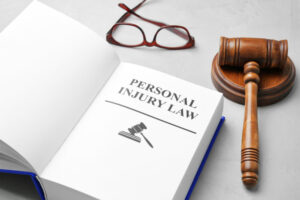Accidents happen, and when they result in personal injuries, insurance claims or legal proceedings may be necessary to determine liability and compensation. In Texas personal injury cases, comparative fault laws might play a crucial role in determining how damages are awarded based on the degree of fault of each party involved. The concept of comparative fault has different forms and various impacts on personal injury cases in Texas.
However, to understand how comparative fault works in Texas personal injury cases, it's best to understand how a personal injury case works from an experienced Austin personal injury lawyer and about the elements of negligence.
The Elements of Negligence in a Personal Injury Case
To obtain compensation for your losses, your personal injury claim must establish four elements:
Duty of Care/Standard of Care
The first element involves demonstrating that the opposing party had a duty of care to you or needed to exercise reasonable caution and prudence. Typically, a lawyer can easily do this. Legal statutes, regulations, and even common sense establish the standard of care one owes to others. For example, drivers must stop at red lights or occupied crosswalks.
Breach of Duty
Following the duty of care, you must prove that the other party failed to uphold the established standard. For instance, a responsible driver wouldn't have violated traffic laws by driving recklessly or speeding.
Once you've successfully established the duty of care and breach of duty, you effectively establish the at-fault party's liability for the consequences of their actions. The next step is to connect their actions with your injuries and damages.
Causation

With liability established, the next step is proving that you sustained compensable damages due to the incident. You need to link the actions of the other party to your injuries.
This link, known as causation, requires the other party's actions to directly cause your damages.
For instance, if another driver ran a red light and collided with you, causing a broken pelvis and hip that required surgery and six months off work, the driver's negligence directly led to your injuries and the subsequent damages. You wouldn't have faced medical treatment or work absences without the driver's negligent behavior.
Damages
Lastly, your personal injury lawyer must prove that you incurred actual damages due to the injuries caused by the at-fault party's actions. You must establish that you suffered tangible harm quantifiable in monetary terms.
Demonstrating damages demands substantial evidence. Examples of evidence that contribute to establishing damages encompass medical bills from your treatment, pay stubs verifying lost income, and expert testimony outlining the impact of your injuries on your professional life and capacity to perform job-related tasks.
Successfully addressing each of these components creates a strong basis for your personal injury claim. Your attorney will carefully gather evidence, construct persuasive arguments, and present your case to seek & negotiate compensation with the insurance company for the harm you endured.
Each component is integral to the overall structure of your claim, and a skilled attorney will navigate these intricacies to build a compelling case on your behalf.
Comparative Fault: A Brief Overview
Comparative fault, or comparative negligence, is a legal principle that addresses situations where more than one party shares fault for an accident or injury. Instead of assigning full responsibility to one party, comparative fault laws allow the allocation of fault between all involved parties. Insurers use this allocation to adjust the amount of compensation each party should receive.
Texas law follows the modified comparative fault rule, specifically the 51 percent Bar Rule. Under this rule, an injured party can seek compensation if their degree of fault is not greater than 50 percent. Still, the total compensation they receive will decrease by their percentage of fault, which is similar to the framework of pure comparative fault (see below).
Types of Comparative Fault
The two main comparative fault systems are pure comparative fault and modified comparative fault. Each state sets laws dictating which system applies to personal injury cases in state civil court. Here's how they differ:
Pure Comparative Fault
In states with pure comparative fault, injured parties can recover damages regardless of their degree of fault. However, their compensation decreases by their percentage of fault. For example, if an injured party is 30 percent at fault, their compensation will decrease by 30 percent.
Modified Comparative Fault (51 Percent Bar Rule):
Texas adheres to the modified comparative fault system with the 51 percent Bar Rule. Injured parties can recover damages as long as their fault is not greater than 50 percent. However, suppose their fault is equal to or greater than 51 percent. In that case, Texas law bars them from recovering any compensation at all for their injuries.
Impact on Personal Injury Cases
The application of comparative fault laws can significantly impact personal injury cases. Here's how it works in various scenarios. Remember that all case results will vary, and these scenarios are only examples to demonstrate how pure comparative and modified comparative fault work.
Pure Comparative Fault Scenario
Suppose a pedestrian is crossing the street outside a designated crosswalk, and a driver fails to yield, hitting the pedestrian. If insurers determine the pedestrian was 20 percent at fault for not using the crosswalk, their compensation will decrease by 20 percent.
Modified Comparative Fault Scenario
Now consider a car accident in Austin where both drivers are found partially at fault. If Driver A is 40 percent at fault for speeding, and Driver B is 60 percent at fault for running a red light, Driver A can still recover damages because their fault is less than 50 percent. However, their awarded compensation will decrease by 40 percent.
Gathering Evidence for Comparative Fault Cases
When navigating a personal injury case involving comparative fault, substantial evidence must establish the degree of fault for each party. You need to ensure an insurance company does not assign a greater percentage of fault to you than necessary, and your lawyer knows how to protect your rights to compensation by presenting evidence of the other party’s fault.
A Texas personal injury attorney can potentially use this evidence to decrease your liability and maximize your injury compensation:
- Witness statements: Eyewitnesses can provide valuable accounts of the accident and help establish the sequence of events.
- Photographs and videos: Visual evidence, such as photos and videos of the accident scene, damages, and road conditions, can help reconstruct the incident.
- Police reports: Official police reports can provide an objective account of the accident and include details about violations and citations.
- Expert testimony: Depending on the nature of the case, expert witnesses, such as accident reconstruction specialists, medical professionals, or engineers, can provide insights into the accident's dynamics.
- Medical records: Medical records can document the injuries sustained by each party and help establish a connection between the injuries and the accident.
- Surveillance footage: If available, surveillance footage from nearby cameras can offer an objective view of the accident.
Understanding Damages in a Personal Injury Case
In personal injury claims, damages play a pivotal role in compensating individuals who have suffered injuries due to someone else's negligence.
Damages refer to the losses and hardships that injured victims endure due to their injuries. They serve as a way to provide financial relief and address the exceptional circumstances faced by those who suffered harm.
In legal terms, the party responsible for the injury must cover the damages suffered by the injured party.
Economic or Special Damages
One primary category of damages is economic damages, which are quantifiable financial losses incurred due to the injury. These damages are easy to calculate, as they involve concrete monetary figures.
Some common components of economic damages include:
- Medical expenses: Medical bills often constitute a significant portion of economic damages. Expenses incurred for ambulance services, emergency room care, hospital stays, diagnostic tests, physical therapy, and physician services all fall under this category. Additionally, costs for necessary medical equipment, prescriptions, and travel to medical appointments count towards damage compensation. Future anticipated medical expenses for ongoing treatment are also critical economic damages.
- Lost income: If the injury led to missed workdays or affected your ability to earn income, compensation for lost income counts towards your total damages. This includes regular income, bonuses, commissions, and even self-employment income. Documentation such as pay stubs and employer communications can establish the extent of lost income. For long-term or permanent disabilities preventing a return to work, specialized financial analysis may be employed to calculate future lost earning potential.
- Property damage: If the personal injury arose from a motor vehicle accident, a slip and fall, or other incidents, the victim might have property damage. Victims also deserve compensation for the cost to repair or replace their lost or damaged property through a personal injury claim.
Non-Economic or General Damages
In addition to economic damages, non-economic damages are critical in personal injury claims. Unlike economic damages, non-economic damages don't have a fixed monetary value and aren't substantiated by concrete financial evidence. Instead, they address intangible losses that impact a victim's quality of life. These damages are often more complex to quantify and require legal experience.
Non-economic damages include:
- Pain and suffering: Enduring physical pain and emotional distress from an injury can profoundly impact injured parties. Compensation for pain and suffering aims to address these intangible hardships and acknowledge the mental and emotional toll inflicted by the injury. You should also document your pain and suffering to prove how much your life was impacted because of injuries.
- Scarring or disfigurement: Injuries resulting in visible scars or disfigurement can lead to psychological distress and diminished self-esteem. Nothing can remove such disfigurement, but compensation aims to recognize the emotional struggles and challenges associated with these changes in appearance.
- Loss of consortium: Injuries can strain relationships with loved ones, including spouses and children. Loss of consortium accounts for the loss of companionship, affection, and even intimate relations resulting from the injury.
- Loss of enjoyment of life: When injuries prevent individuals from engaging in activities they once enjoyed or disrupt their planned experiences, compensation for the loss of these opportunities is considered. This includes missed family events, hobbies, recreational pursuits, and other activities contributing to one's quality of life.
Quantifying non-economic damages can be complex, as they lack concrete monetary values. Insurance companies often downplay their significance due to the challenge of proving these intangible losses. However, these non-economic losses are equally important in acknowledging the full impact of an injury on an individual's life.
Navigating the realm of damages in a personal injury case requires the skills and knowledge of a seasoned Texas personal injury attorney. Their experience and legal acumen are essential in assessing the full scope of damages, advocating for fair compensation, and ensuring that injured parties receive compensation for both economic and non-economic losses.
If you suffered a personal injury, a reputable personal injury lawyer can explain your rights and pursue rightful compensation for your damages.
Consulting with an Experienced Texas Personal Injury Attorney
Navigating comparative fault laws in Texas personal injury cases requires a deep understanding of the legal system. If you're involved in such a case in Texas, seeking guidance from experienced personal injury attorneys is essential. They can build a strong case for you, gather evidence, negotiate with insurance companies, and advocate for your rights to ensure you receive the compensation you deserve.
Understanding the nuances of Texas comparative fault laws is crucial when pursuing a personal injury claim. Awareness of the modified comparative fault system and its impact on compensation can help injured parties navigate the legal process more effectively.
With the support of knowledgeable legal professionals from a top-rated personal injury law firm in Texas, you can navigate the complexities of comparative fault and work toward achieving a fair and just resolution for your personal injury case.


